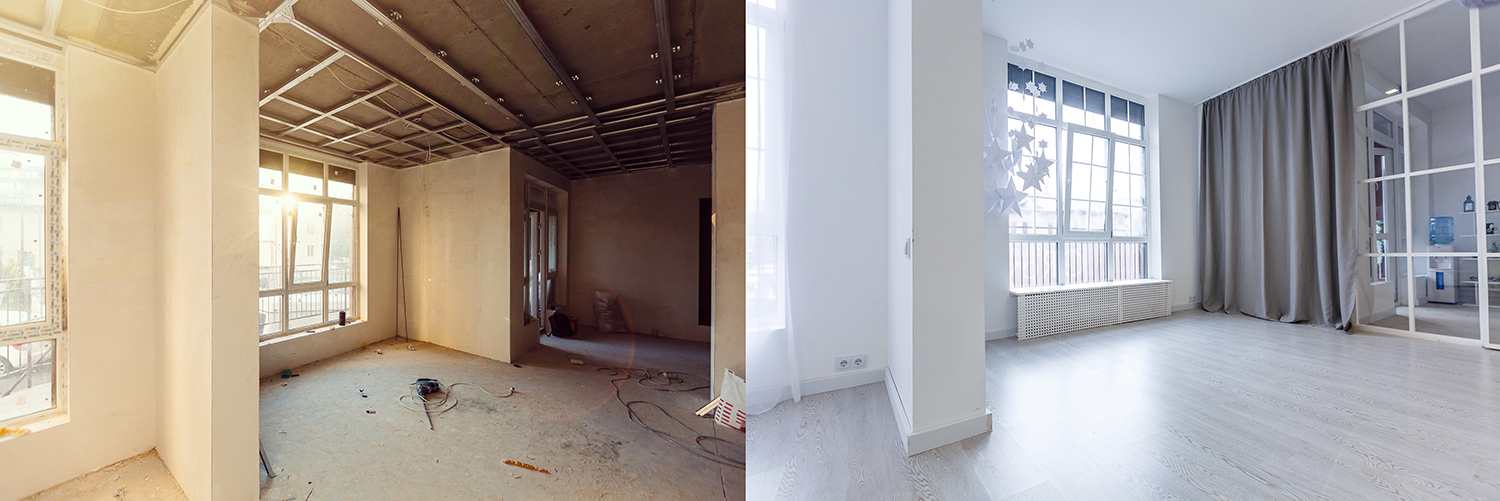As I speak to both Buyers and their Realtors who may be looking for a home to renovate I’m often asked to describe the Renovation lending process at a high level. The same is true when a homeowner speaks to me about funds to update their current home. Anyone considering buying a home to rehab may have concerns about the process and whether it is right for them.
In this post, I have written a quick, easy to read, high level overview describing the Players involved and the Renovation loan buying process itself. In this way, a Buyer who may be reluctant to embark on a renovation project can have the 6 steps clear before making a decision.
As a Loan Officer who specializes in all forms of Renovation financing I always say “Buy the worst home in the best location.” That way there will likely be similar finished homes used to appraise your property to its highest potential “as completed” value. This finished or future value is the key to Renovation lending.
Renovation mortgages includes HomeStyle*, FHA 203K, VA Renovation Loan, Jumbo Renovation Loan and Investor 1 to 4 Renovation Loan. A past blog gives a detailed overview to these at: https://perryfarella.com/2018/03/home-renovation-mortgages-what-different-loans-are-available-for-buyers-home-owners-to-finance-a-renovation/
Below I define the Players you can expect to interface with & their Roles in the process along with the 6 Steps from beginning to Renovation completion.
Players:
- Realtors – Work with Buyers to find properties & List properties for sale on behalf of Sellers
- Loan Officer – Offers Renovation Loan options & education for all on the process
- Home Inspector – Optional Home Inspection (not required for a rehab loan but you may still do one if you wish)
- HUD Consultant – Does required Construction Inspections & writes SOR (Scope of Repairs) document defining all required repairs to make a home safe & livable plus recommended & desired updates Buyer wants
- Appraiser – Appraises home to future “As Completed” Value based on reviewing the Contractors written description of Renovation work with related labor & material costs
- Contractor(s) – Executes the Renovation work to completion
- Draw or Distribution Specialist – Pays Out Funds to Contractor from the loan & monitors property Title during Renovation (an employee of Lender)
Steps:
- Buyer finds a home and gets under contract for it or already owns the home
- HUD Consultant visits with Buyer to inspect the home for repairs that fall into 3 categories- Mandatory, Recommended & Desired repairs
- Mandatory would be items like holes in roof or walls, missing pipes, missing furnace or anything that would be dangerous and prohibit safe use of the home
- Recommended would be items the Consultant sees that may wear out soon like a roof that has a year left to it or older less efficient windows
- Desired would be items like new kitchen cabinets & counter tops, opening a wall between kitchen and living room, re-finishing wood floors or anything new the Buyer wishes to install as part of the Renovation
- A Scope of Repairs report document is prepared by the HUD Consultant defining all repair items with one of the 3 above categories (M,R,D) along with a projected labor and material cost for each that may include Architect Plans or Permits if needed
- Buyer visits the property with General Contractors who will see a version of the Scope of Repairs document prepared by HUD Consultant called a Bid On Repairs or BOR – Difference is BOR will have all rehab work tasks listed same as SOR but no projections of expected costs so Contractor can make an honest bid to execute exactly that rehab work but not be biased with seeing expected cost projections from HUD Consultant as Contractor may bid less/more so should not know any projected numbers, just a detailed itemization of all work needed and amount of materials required
- Buyer selects a Contractor based on seeing completed BOR and Lender will check licenses, insurance, etc. to be sure Contractor can handle the job
- Buyer has signed a loan application with Lender which includes funds for the rehab & authorizes an Appraisal report to be done
- Lender orders an Appraisal based on the Contractors written description and costs for all work and property is appraised to its finished or “as completed” value to approve the loan
- Loan is closed, Seller is paid off, Realtors receive any commissions due and Contractor begins Renovation work after closing
In writing above I wanted to be clear about both the Players involved and the 6 Steps involved for those that are new to the idea of undertaking a purchase or refinance Renovation project. It really is not a tiring process and the HUD Consultant is key to watching out for the interest of the Buyer/Owner as well as the Lender. Plus, a Loan Officer who is very experienced in Renovation lending will be a great asset for you.
I hope this post has been helpful and encouraging to those that may have thought a Renovation project was too complex or beyond their ability to manage. My intent is always to inform, educate, and generate discussion. Please call me or email me directly or visit my website for more information on renovation loans. I welcome your comments and questions!

